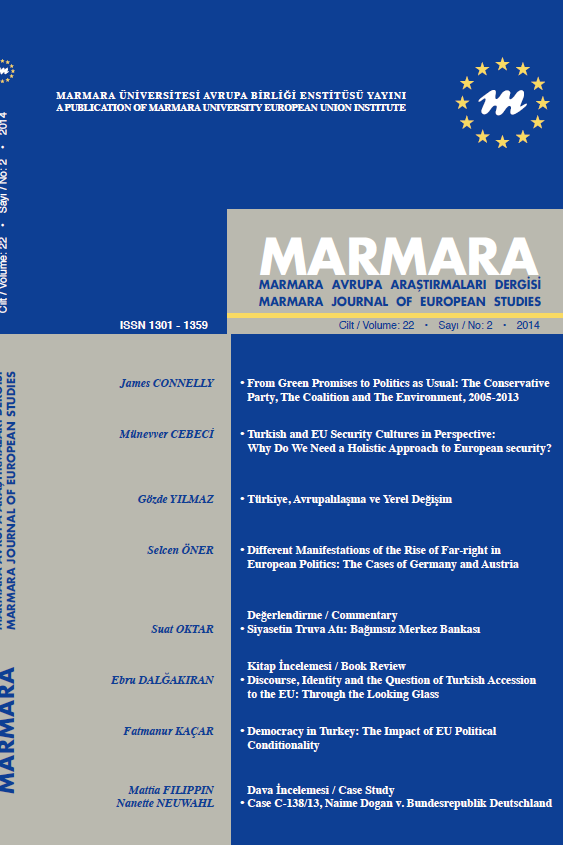EU - RUSSIA : PARTNERSHIP AND COOPERATION
Since 1989, when the Community concluded a comprehensive agreement with the Soviet Union on the basis of Articles 113, 228, and 235 of the EEC Treaty, which was to constitute an essential part of the normalization of mutual relations, both the EC and the Soviet Union have undergone considerable changes. While EC was transforming into EU and remaining a key organization in Europe by reinforcing the integration among its members through the Treaty of European Union, the Soviet Union had disintegrated. Thus with the breakup of the Soviet Union, the balance of power in the EU had also changed; its potential eastern limits became more blurred than ever and EU was forced to revive its policies concerning the formal states of the eastern bloc. In late 1991, EU had first realized that the original agreement which was signed with the USSR in 1989, had to be replaced with new agreements, due to the formation of a number of successor states of varying size and structures. Thus the EU opt- ed a new approach to its future relations with the new republics through partnership and cooperation agreements which are intended to fall somewhere between a trade and cooperation agreement and an association agreement. In 1994, agreements were signed with the ex-Soviet republics that laid down the framework for future political, commercial and cultural cooperation and set down a new legal basis for the development of trade and investment links. The partnership agreement with Russia also established regular political dialogue and supported Russia's transition to market oriented economic system based on human rights and democratic principles.
Anahtar Kelimeler:
PARTNERSHIP, COOPERATION, EU - RUSSIA
EU - RUSSIA : PARTNERSHIP AND COOPERATION
Since 1989, when the Community concluded a comprehensive agreement with the Soviet Union on the basis of Articles 113, 228, and 235 of the EEC Treaty, which was to constitute an essential part of the normalization of mutual relations, both the EC and the Soviet Union have undergone considerable changes. While EC was transforming into EU and remaining a key organization in Europe by reinforcing the integration among its members through the Treaty of European Union, the Soviet Union had disintegrated. Thus with the breakup of the Soviet Union, the balance of power in the EU had also changed; its potential eastern limits became more blurred than ever and EU was forced to revive its policies concerning the formal states of the eastern bloc.In late 1991, EU had first realized that the original agreement which was signed with the USSR in 1989, had to be replaced with new agreements, due to the formation of a number of successor states of varying size and structures. Thus the EU opt- ed a new approach to its future relations with the new republics through partnership and cooperation agreements which are intended to fall somewhere between a trade and cooperation agreement and an association agreement.In 1994, agreements were signed with the ex-Soviet republics that laid down the framework for future political, commercial and cultural cooperation and set down a new legal basis for the development of trade and investment links. The partnership agreement with Russia also established regular political dialogue and supported Russia's transition to market oriented economic system based on human rights and democratic principles.
Keywords:
PARTNERSHIP, COOPERATION, EU - RUSSIA,
___
- -
- ISSN: 1301-1359
- Başlangıç: 1991
- Yayıncı: Marmara Üniversitesi
Sayıdaki Diğer Makaleler
AVRUPA YURTTAŞLIĞI VE FRANSA'DAKİ HUKUKİ SİYASİ TARTIŞMA
THE CO-ORDINATION OF THE EU'S INTERNATIONAL POLICIES A HOST OF UNCERTAINTIES
EU - RUSSIA : PARTNERSHIP AND COOPERATION
THE EUROPEAN UNION AND THE CHALLENGE OF ENLARGEMENT
REGIONALISM AND WORLD ORDER AFTER THE COLD WAR
THE POLITICAL ECONOMY OF REGIONALISM IN WORLD TRADE : IS IT COMPATIBLE WITH MULTILATERALISM?
M. Sait AKMAN, Muzaffer DARTAN
FULL MEMBERSHIP· UTOPIA? PROBLEMS AND PROSPERITY IN TURCO-EUROPEAN RELATIONS
THE EU AND MEDITERRANEAN COUNTRIES
